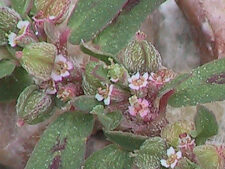
This native annual creeping plant often forms large mats in the most inhospitable sites (C,D). Its hairy stems contain a milky sap. Opposite oval leaves are up to 1/2 inch long often with a dark reddish spot (A,B). Floral cups (cyathia), too small to be seen without magnification, enclose individual male and female flowers and 4 glands. Each gland has a pinkish to white petal-like extension responsible for the inconspicuous but visible “flower” (B,E). The fruit is a hairy, globular capsule with three compartments, each containing one seed (E).
This plant blooms from June through October in disturbed areas and roadsides. It is common in disturbed areas at both Fontenelle Forest and Neale Woods.
Spotted Spurge is one of several creeping plants which thrive in our most inhospitable places. Dark leaf spots, when present, separate it from similar creeping, mat-forming species of Euphorbia that otherwise are not possible to separate in the field. Knotweed (Polygonum arenastrum), another inconspicuous creeping plant found in similar habitats, has “knotted” or swollen areas where the leaf joins the stem, and stems do not contain milky juice. Another creeper of inhospitable spots, Prostrate Vervain (Verbena bracteata), has blue flowers and larger, divided leaves.
The content of NatureSearch is provided by dedicated volunteer Naturalists of Fontenelle Forest who strive to provide the most accurate information available. Contributors of the images retain their copyrights. The point of contact for this page is: Neal Ratzlaff.

 Identification
Identification


